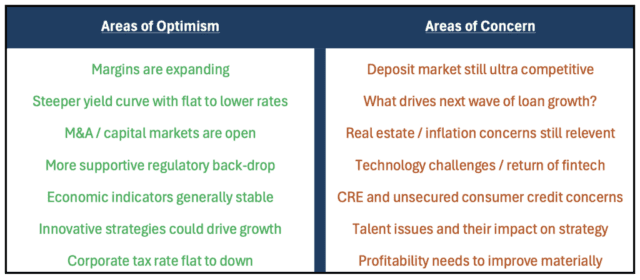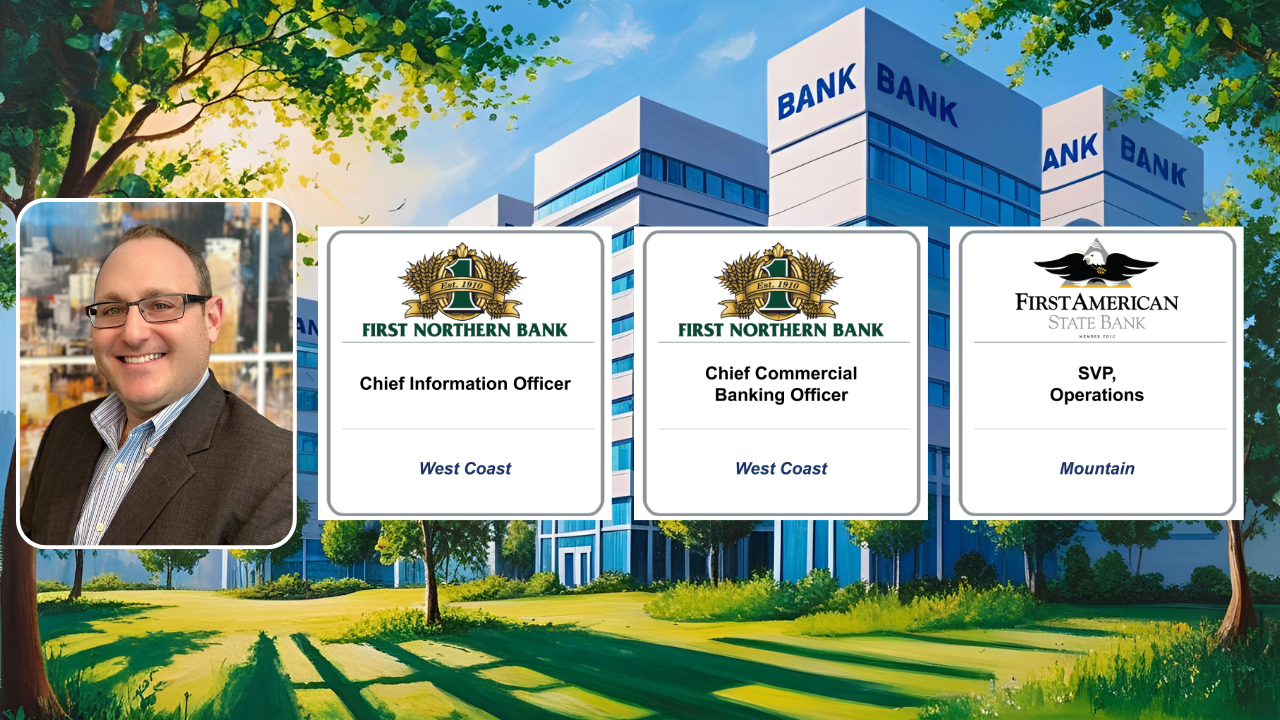For all the challenges facing bankers during 2024, the year ended with a flurry of activity and optimism across the bank industry only to be rewarded by a -9% pull-back in the KBW Regional Banking Index (KRX) over the final month, compared to a -2% pull-back in the S&P 500.
Sometimes years are roller coasters until the bitter end. However, with the calendar turning we still think there is reason for optimism in 2025 for the banking industry, albeit balanced by some new and old areas of caution.
We have a high degree of confidence that after a period of at least two years where the bank industry traded virtually as one (Maximus Decimus Meridius would be proud at least), we believe the final stages of 2024 paved the way for 2025 to be a year of increased bank performance differentiation.

The bank industry, utilizing the KRX as a proxy to normalize for the outsized benefit of higher capital markets activity for the largest banks, has somewhat normalized from a valuation standpoint since the end of summer now trading within 5-10% of historical price-to-earnings (P/E) averages. This is, of course, making the large and usually incorrect assumption that consensus estimates are accurate.
While bullish bank investors will point to additional valuation expansion as an opportunity for the broader group, we think the set-up for 2025 suggests that banks will be able to differentiate more effectively from their peers from a stock performance perspective (positively or negatively), especially considering the more stable macro-outlook.
Why do we feel this way?
The net interest income growth bar is high; not all will reach it. The broader industry trend on net interest income and net interest margin is clearly biased higher, due to a combination of re-accelerating loan growth, lower deposit cost and normalizing liquidity. Having said that, the bar of expectation is much higher than at the onset of 2024, with investment banks generally expecting double digit growth in net interest income (i.e. 12+%) on median according to their outlooks.
-
- Loan Growth – We still don’t have a high degree of confidence on what the broader drivers of loan growth will be. Non-bank competition, regulatory guidelines on concentration and adjusted ALCO strategies could make the CRE asset class, once the darling of growth for small and mid-sized banks, a limited growth driver. Very few banks are built to be strong C&I lenders, in our opinion, so that begs the question – where (or who) is incremental growth coming from?
- Deposit Trends – You don’t have to scroll the internet for very long to see most incremental deposit account opening is occurring at the largest banks or on digital native platforms. We think deposit strategies for 2025 are going to have to become more pragmatic, while core customers are always the goal, a more diverse deposit mix with less reliance on brokered is a more realistic target near-term. We think banks will continue to try and expand the tools on their deposit belts in 2025 to keep some open capacity with wholesale if needed.
- Liquidity – Do banks continue to carry higher relative cash balances as rates continue to decline? Or do we begin to see a reduction in overall liquidity which would be positive for margins and profitability? It has also been almost two plus years with banks largely steering away from significant securities purchases, we don’t anticipate that to change in 2025 but some banks will likely be tempted to lock in some rate as cash yield continues to move lower and deposit balances stabilize.
M&A Outcomes to Vary Widely; M&A and Capital Markets 2025 Outlook commentary from D.A. Davison’s Managing Director, Steve Nelson:
There are several trends that support continued increases in M&A activity and capital offering issuances for the banking space in 2025 from the levels seen in 2024 (and 2023). Some of the improvement is a function of mean reversion to historical levels; but a more accurate read is as we enter 2025, there is a better understanding and consensus among buyers / sellers / investors regarding the impact of interest rates on operating results, M&A deals, stock values and which banks are helped/hindered. There are also expectations for a reduced regulatory burden on the sector which should result in lower operating expenses and a more streamlined M&A approval process.
- M&A – Over the past decade the sector has averaged 205 bank & thrift M&A deals per year. However, in 2023 there was a 35-year low of only 102 transactions and 2024 there were 128 deals… materially below historic levels. The lower level of M&A deals has not been a function of buyers not having an openness to buy or sellers not wanting to sell. This slowdown is a direct result of the rapid increase in interest rates in ’22 and ’23 and the ripple thru on bank values. Institutions that were particularly susceptible to value erosion had a high level of long duration, low fixed rate assets on their balance sheet. Given the marked to market accounting required in an M&A deal, those unrealized losses (whether it is in the security portfolio or in the loan book) have to be realized upon the closing of a transaction, oftentimes resulting in a (notably) lower value a buyer could convey to a seller. In June/July 2024, as the interest rate headwinds impacting the sector began to subside, M&A activity started to rebound from these historic lows for a select group of well-positioned buyers and sellers.
- M&A Activity in 2025 – We expect the level of activity to increase from the 128+/- announced deals in 2024; but, still below the 10-year average of 205 deals… our best estimate for 2025 would be in the 150+/- deal range. To the extent M&A pricing increases to the long-term median of 150% of tangible book (vs. the 125% of TGBV in 2024), we could see exceeding 150+/- deals.
- Balance Composition Matters – In addition to strong asset quality, accessing and growing good core deposits is always a positive. This will continue to be true to a heightened degree in 2025. Banks with strong core funding bases and lower cost deposits will be better buyers and more attractive sellers. On the asset side, banks with a higher % variable rate loans and/or a shorter duration loan portfolio will fare better than those with longer maturity, lower yielding, fixed rate loans. It is a simple equation: low cost deposits + assets that are repricing at higher yields = a better M&A value.
- Selectivity of Buyers – There are many historically active buyers who have not announced a deal for 3+ years. These buyers are currently going thru their pipeline of conversations to figure out the best deal for them to allocate resources toward in 2025. Since it is unlikely these buyers are going to have multiple pending bank M&A deals at one time, the question they are asking themselves is, “Are we going to use our one silver M&A bullet on Bank XYZ this year?” As such, if a bank is a near/mid-term seller, knowing your buyer(s) and where you fit into the buyers’ pipelines / strategic plans is critical.
- Interest Rate and Credit Marks – Both marks will still have a notable impact on M&A math in 2025. While each transaction is different, in the aggregate, we expect credit marks to start to normalize for the sector at slightly higher levels than the -1.5%+/- average in 2024. Conversely, we expect the interest rate marks to improve from the -4.5% average seen in 2024.
- Impact of Credit Unions – In 2024 credit unions announced the acquisition of 21 banks (representing 16.4% of total bank M&A activity in the U.S.), with an average asset size for the seller of $515 million. We expect credit unions to continue to be active buyers of community banks U.S. in 2025, especially for those banks under $1 billion in assets.
- Capital Markets – Similar to bank M&A, in the latter half of 2024, common equity, preferred and debt issuances for banks increased from the anemic levels in 2023. As we enter 2025, the capital markets are open for the majority of publicly traded banks in the U.S. While the bank-focused investors have not left the sector over the past three years, many of the generalists and GARP investors pivoted their focus to other industries. However, starting in July 2024, the generalists started to allocate more investment dollars to the banking space, and we expect this to continue in 2025.
- Common Equity – Although there have a been a few common equity offerings completed by banks in the second half of 2024 that were truly for “general corporate purposes”, in the past six months there have been two types of equity deals that have garnered broad investor support. The first is an equity offering announced in conjunction with a (oftentimes large) M&A deal by the issuer. The common equity is being raised to augment pro forma capital ratios and/or to reduce the pro forma CRE / Total Risk Based Capital (a regulatory hot button ratio). The second type of equity offering investors have supported is when a bank repositions its investment and/or loan portfolio by selling low yielding assets. For the right issuers, using the proceeds in a sound manner, bank investors have been supportive of these strategies. If the sector continues to perform well, we expect these trends will continue and broaden in 2025.
- Subordinated Debt – Starting in the summer of 2020 and into early-2022, hundreds of banks issued billions in subordinated debt at historically low rates. Approximately 95% of the sub-debt issued in that timeframe had a 10-year maturity, a fixed rate for the first five years and in year 6 the security would flip a variable rate (typically a spread above SOFR). That 5-year (generally low) fixed rate anniversary is going to come up starting in the summer of 2025 for the 2020 issuances, at which time the sub-debt will reprice to a (notably higher) variable rate. As such, as market conditions permit, in 2025 we expect to see a refinancing of a significant portion the ’20 and ’21 sub-debt vintages.
- Bank IPOs – The bank IPO window has largely been closed for the past three years, with only three IPOs completed. Whether it is the need for shareholder liquidity, a currency for acquisitions and/or the need for growth capital, there are a number of quasi-public banks and private banks where an IPO could be a good solution. In 2025 we think more banks will choose to compete an IPO because those company-specific strategic and financial needs can now be met with increased investor interest and confidence in the sector.
If I could have $100 for every time I read or hear “one-off” related to credit deterioration in 2025, I’d probably become a rich man. The consensus on the street is credit costs shouldn’t accelerate much in 2025 relative to 2024 and, at this point, I don’t see a lot of data that makes me want to deviate off this consensus view. Having said that, I do believe investors will be skeptical around credit for at least the first half of 2025, and possibly longer depending on broader macro trends. There are quite a few banks out there looking to recover from below-average credit performance in 2024, which will be a multi-quarter process.
- CRE – While rates have alleviated somewhat, we are still much higher than where we were during the early days of COVID and there is a substantial amount of paper outstanding that was originated ~3-5 years ago at lower rates which will mature in 2025. The trend of lower rates makes me feel better about banks continuing to navigate CRE credit issues, although one-off losses / write-downs of size are still very possible and likely to occur over the course of the year.
Technology and talent are difficult to quantify for external stakeholders such as investors, but that doesn’t make them any less important. With better profitability from expanding margins, banks should have opportunities to add talent and bulk up succession planning in 2025, in our view, particularly if we are in a more growth focused environment.
- Technology Spend to Ramp – With a path towards lower rates and expanding margins, plus a more competitive landscape digitally after a several year re-set in the fintech world, we think banks will look to ramp on technology spend in 2025. These initiatives can cover many areas, ranging from capabilities to infrastructure or partnerships to help attract new customers. To orchestrate these investments, we think you will see more banks evolve their IT / digital infrastructure to include Chief Technology or Innovation officers, versus Chief Information Officers historically.
- Fintech Competition – After the neobank / digital lending craze at the onset of COVID, we saw a notable pullback in the growth of these platforms due to more difficult capital raising conditions and a limited secondary market for loan sales. We think 2025 will be very different, with digital native platforms pushing growth with a greater degree of confidence that they will have access to capital at reasonable valuations. Secondly, there is an element of survival of the fittest as many of the fintechs who have weathered the storm are better positioned to accelerate growth in a less competitive environment.
- A Hot and Competitive Talent Market (with an assist from my colleague, Brian Love, Head of Banking & Fintech recruiting at Travillian) – Early signs point to a ton of proactivity in the talent market. We seem to have finally flipped from a candidate-driven market to an opportunity-driven, or client-driven, market. Think big, but know that there may be other sharks circling the water. This also makes retention even more important across banks key ranks; banks will need to keep investing in employee development through coaching, training, career pathing, and mentoring. Compensation, both guaranteed or unguaranteed, will need to be at or exceeding market with additional tweaks likely necessary for banks to protect their home-grown talent.
Top Performing Bank Stocks of 2024: M&A or Growth Driven
The top three performing banks in the U.S. during 2024 with at least $1.0 billion market capitalization as of year-end 2024 were all cut from different cloths, but generally we’d say had some form of M&A or growth catalyst associated with.
- Coastal Financial Corporation (CCB); +96% – CCB is one of the industry leading banking-as-a-service bank partners, and frankly given the year we saw in terms of regulatory orders coming down on BaaS banks, its notable to see a BaaS bank take the top spot. CCB had a stable year of earnings and was insulated from industry concerns around deposit mix, margins and CRE credit. They also recently raised capital in 4Q24 citing growth in their BaaS segment, CCBX, and it appears the market has optimism on the bank’s growth outlook.
- Heartland Financial (HTLF); +62% – In April 2024, UMBF announced that they were acquiring HTLF for $1.9 billion, one of the first deals to break the logjam that existed for most of 2023 and early 2024. In addition to the upfront premium HTLF was awarded in the take-out, UMBF’s share price has increased meaningfully with the broader KBW Regional Banking Index rally that occurred in the back-half of 2024, which has driven that deal value to about $2.6 billion based on current pricing.
- First Citizens Bancshares (FCNC.A); +49% – First Citizens made noise in March of 2023 when they announced the FDIC-assisted acquisition of Silicon Valley Bridge Bank, bringing on $52 billion of deposits and $72 billion in loans, nearly doubling the size of the institution. First Citizens also saw their revenue streams expand to include a leading market share venture banking business, but also other private banking and digital opportunities. An FDIC-assisted deal of this size certainly had its ups and downs from a stock performance perspective, but it would appear First Citizens’ ability to integrate this transaction, significantly grow earnings, and avoid any regulatory issues (unlike New York Community) resulted in strong stock performance in 2024.
So what do we expect to see in 2025? Here are some predictions from Travillian:
- Digital strategies will make a modest comeback, led by banking-as-a-service but perhaps even a few brave souls with venture back into the digital asset eco-system (we have already heard about the re-entry of some banks into the market at the end of 2024). We believe it will be a somewhat slower process than many realize, however. Also, don’t sleep on stablecoins either, which you don’t hear much about in the traditional finance world anymore although billions of dollars continued to be invested into these types of projects. PayPal partnered with Paxos to launch a stablecoin in August of 2023, and many digital asset native firms continue to look to stablecoin projects for growth. It feels inevitable to us that in a friendly regulatory environment banks don’t get more involved here.
- Stock performance around M&A remains relatively favorable for at least the first half of 2025, as investors remain aligned with strong-positioned buyers and even supporting capital raises where needed as we saw later in 2024. We expect the stock performance around M&A in the back-half of 2025 to return to a more “normal” environment (i.e., buyers stocks go down on announcement modestly, 10-12% premiums for sellers on average).
- Posting balance sheet growth on a net-basis, while improving profitability in 2025 will be a challenging feat. We’d feel comfortable owning premium valued banks that are able to accomplish this dynamic in 2025, and we think investors will prefer to own highly valued growth banks versus cheaper banks with limited growth stories and below-average profitability. We don’t think 2025 will solely be a year where “the rich get richer,” however, as credit improvement stories and liability sensitive banks are likely to see some valuation upside if current macro-economic trends persist.
- We are going to see an uptick in bank / fintech merger activity. So much focus in the bank space is on bank-to-bank merger activity, although in a better regulatory environment we think you will see an up-tick in non-traditional M&A involving banks. Based on our conversations with industry participants, an increasing number of fintech companies are looking to acquire banks. There should be at least a couple notable deals in 2025 that step-out of the traditional boundaries of bank M&A, in our view, and it will be interesting to see how the market reacts.












